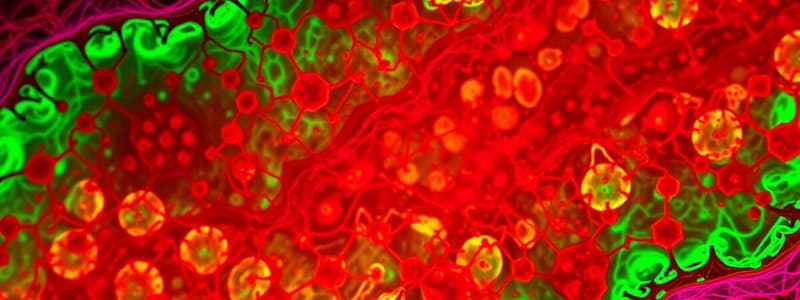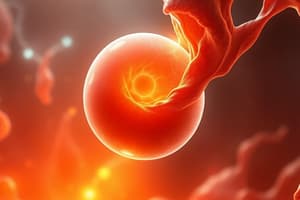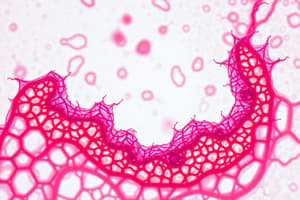Podcast
Questions and Answers
What is epithelial to mesenchymal transition (EMT) and its significance in cancer development?
What is epithelial to mesenchymal transition (EMT) and its significance in cancer development?
EMT is the process by which epithelial cells acquire mesenchymal characteristics, enabling them to gain motility, which is vital for cancer invasiveness and metastasis.
How do the characteristics of epithelial cells contrast with those of mesenchymal cells?
How do the characteristics of epithelial cells contrast with those of mesenchymal cells?
Epithelial cells have cohesive interactions and a well-organized structure with tight junctions, while mesenchymal cells exhibit weak interactions, lack organization, and are not polarized.
Why are epithelial cells considered stable and not motile under normal conditions?
Why are epithelial cells considered stable and not motile under normal conditions?
Epithelial cells are tightly packed and linked by tight junctions, which restricts their mobility and maintains the integrity of tissue layers.
What physiological roles does EMT play during normal development?
What physiological roles does EMT play during normal development?
In the context of cancer, what does it mean for epithelial cells to acquire motility?
In the context of cancer, what does it mean for epithelial cells to acquire motility?
Describe the consequences of mesenchymal cells not being polarized.
Describe the consequences of mesenchymal cells not being polarized.
What role do tight junctions play in the behavior of epithelial cells?
What role do tight junctions play in the behavior of epithelial cells?
What distinguishes mesenchymal cells from epithelial cells in terms of cell adhesion?
What distinguishes mesenchymal cells from epithelial cells in terms of cell adhesion?
How does the presence of vimentin serve as a marker for mesenchymal cells?
How does the presence of vimentin serve as a marker for mesenchymal cells?
Explain the significance of epithelial to mesenchymal transition (EMT).
Explain the significance of epithelial to mesenchymal transition (EMT).
What role does E-cadherin play in epithelial cells compared to mesenchymal cells?
What role does E-cadherin play in epithelial cells compared to mesenchymal cells?
Describe the changes in cell-cell junctions that occur before EMT.
Describe the changes in cell-cell junctions that occur before EMT.
What are the main transcription factors involved in the downregulation of E-cadherin during EMT?
What are the main transcription factors involved in the downregulation of E-cadherin during EMT?
What are the three polarity complexes responsible for the organization in epithelial cells?
What are the three polarity complexes responsible for the organization in epithelial cells?
How do genetic mutations contribute to the reduction of E-cadherin expression in cancer cells?
How do genetic mutations contribute to the reduction of E-cadherin expression in cancer cells?
What happens to mesenchymal cells that undergo mesenchymal to epithelial transition (MET)?
What happens to mesenchymal cells that undergo mesenchymal to epithelial transition (MET)?
What role does N-cadherin play in the progression of cancer cells undergoing EMT?
What role does N-cadherin play in the progression of cancer cells undergoing EMT?
How do tight junctions differ between mesenchymal and epithelial cells?
How do tight junctions differ between mesenchymal and epithelial cells?
What effect do growth factors like VEGF and HGF have on the EMT process?
What effect do growth factors like VEGF and HGF have on the EMT process?
What is the role of the basement membrane in epithelial cell organization?
What is the role of the basement membrane in epithelial cell organization?
What epigenetic changes can lead to the silencing of the E-cadherin gene in carcinomas?
What epigenetic changes can lead to the silencing of the E-cadherin gene in carcinomas?
What is the significance of E-cadherin decrease during the epithelial to mesenchymal transition (EMT) process?
What is the significance of E-cadherin decrease during the epithelial to mesenchymal transition (EMT) process?
How does the expression of polarity complexes like Scribble change during EMT?
How does the expression of polarity complexes like Scribble change during EMT?
What morphological changes occur in epithelial cells as they undergo EMT?
What morphological changes occur in epithelial cells as they undergo EMT?
Explain the role of EMT in normal developmental processes.
Explain the role of EMT in normal developmental processes.
What is the relationship between EMT and cancer invasiveness?
What is the relationship between EMT and cancer invasiveness?
What does MET stand for and how does it relate to EMT?
What does MET stand for and how does it relate to EMT?
List some physiological processes influenced by EMT.
List some physiological processes influenced by EMT.
How do ectopic expressions of cadherins impact EMT?
How do ectopic expressions of cadherins impact EMT?
What are the essential cellular mechanisms activated for cancer cells to migrate?
What are the essential cellular mechanisms activated for cancer cells to migrate?
Describe the role of EMT in pathological conditions.
Describe the role of EMT in pathological conditions.
What is the significance of down-regulating receptors in cancer cell migration?
What is the significance of down-regulating receptors in cancer cell migration?
How does changing the phenotype from epithelial to mesenchymal potentially benefit cancer cells?
How does changing the phenotype from epithelial to mesenchymal potentially benefit cancer cells?
Why do cancer cells need to activate proteases during the EMT process?
Why do cancer cells need to activate proteases during the EMT process?
What distinguishes pathological EMT from physiological EMT in terms of regulation?
What distinguishes pathological EMT from physiological EMT in terms of regulation?
Describe the role of tumor heterogeneity in the EMT process.
Describe the role of tumor heterogeneity in the EMT process.
How do genetic and epigenetic changes collectively influence the EMT process?
How do genetic and epigenetic changes collectively influence the EMT process?
Why is it important for cancerous cells to reduce their proliferation during the EMT process?
Why is it important for cancerous cells to reduce their proliferation during the EMT process?
What factors may lead to bypassing certain events during the EMT process in cancer?
What factors may lead to bypassing certain events during the EMT process in cancer?
In the context of tumor progression, what happens to the organization and shape of the cells during EMT?
In the context of tumor progression, what happens to the organization and shape of the cells during EMT?
What role do metalloproteins play in cancer cell migration?
What role do metalloproteins play in cancer cell migration?
Flashcards are hidden until you start studying
Study Notes
Epithelial to Mesenchymal Transition (EMT)
- EMT allows stable epithelial cells to acquire motility by transitioning to a mesenchymal phenotype.
- It occurs during normal tissue development and is critical in cancer progression, facilitating invasiveness and metastasis formation.
- Malignant epithelial cells detach from the primary tumor to spread and form secondary tumors.
Epithelial Cells
- Characterized by cohesive interactions forming continuous layers with three membrane domains: apical, lateral, and basal.
- Tight junctions and protein E-cadherin are crucial for cell adhesion and organization.
- Epithelial cells exhibit apico-basal polarization of organelles and cytoskeletal components, restricting their mobility.
Mesenchymal Cells
- Lack tight junctions, leading to weak or absent intercellular adhesion, allowing mobility within the extracellular matrix.
- Do not show typical epithelial polarization and are organized differently with vimentin as a specific marker.
- Vimentin filaments are present near the plasma membrane, contrasting with low levels found in epithelial cells.
EMT Process
- Involves a regulated switch from epithelial to mesenchymal phenotype, with the potential for reversal (MET).
- Changes in cell-cell junctions are necessary for EMT, including the dissolution of tight junctions and downregulation of E-cadherin.
- Reduced E-cadherin expression leads to decreased cell adhesion and increased motility, crucial for cancer invasiveness.
Role of Polarity Complexes
- Polarity complexes (Scribble, Crumbs, Par) maintain epithelial cell organization and attachment.
- Loss of E-cadherin disrupts these complexes, fostering a less stable, motile mesenchymal phenotype.
Normal Development Involvement
- EMT is essential during embryonic development, leading to the formation of organs and tissues.
- Key events include the generation of germ layers during gastrulation and differentiation processes.
- Normal physiological processes such as wound healing also involve EMT.
Pathological EMT
- EMT contributes to conditions like fibrosis and cancer, particularly in epithelial cancers.
- Cancer cells must adopt a mesenchymal phenotype to migrate, necessitating gene activation for differentiation and reduced proliferation.
- Steps in cancer cell migration include degrading cell-to-cell junctions and altering cell adhesion properties.
Breast Cancer Specifics
- EMT in breast cancer is critical for transitioning from non-invasive carcinoma in situ to invasive ductal carcinoma.
- Loss of epithelial characteristics and increased motility promote metastasis.
Differences Between Physiological and Pathological EMT
- Physiological EMT occurs in a regulated manner, while pathological EMT may follow an irregular progression.
- Tumor heterogeneity affects the timing and success of EMT among cancer cells; not all cells experience EMT simultaneously or successfully metastasize.
Genetic and Epigenetic Changes
- EMT and MET are influenced by both genetic mutations and reversible epigenetic changes, highlighting the complexity of cancer development and metastasis.### Epigenetic Changes in EMT
- Epigenetic changes are reversible modifications of DNA status, maintaining the DNA sequence.
- Key forms of epigenetic changes include histone modifications, DNA methylation, and alterations in microRNAs (miRNAs).
Key Oncogenes in Epithelial-Mesenchymal Transition (EMT)
- SNAIL, TWIST, and ZEB are critical oncogenes involved in EMT, responsible for promoting tumor invasiveness and metastasis.
- These oncogenes downregulate epithelial markers (e.g., E-cadherin) and upregulate mesenchymal markers (e.g., N-cadherin, vimentin).
- The downregulation of E-cadherin is a crucial early step in EMT, leading to tumor cell invasiveness.
Functional Role of E-cadherin
- E-cadherin prevents tumor cell migration by maintaining cell-to-cell adhesion, acting as a tumor suppressor.
- Loss of E-cadherin function due to genetic mutations or epigenetic changes facilitates cancer progression.
Additional Factors Influencing EMT
- Growth factors, such as FGF1, HGF, IGF1, EGF, and VEGF, can promote EMT by affecting E-cadherin and N-cadherin levels and activating SNAIL and TWIST oncogenes.
- These factors can induce changes that impact the extracellular matrix, facilitating tumor cell movement.
Process of EMT and Metastasis Formation
- EMT allows epithelial tumor cells to transition to a mesenchymal phenotype, enabling mobility and invasion.
- Key steps include loss of tight junctions, increased motility through matrix degradation, and blood/lymphatic dissemination.
- Successful metastasis requires the reacquisition of the epithelial phenotype through the MET process after establishing in a secondary site.
Transition from EMT to MET
- MET is essential for secondary tumor formation, requiring the downregulation of mesenchymal markers and upregulation of epithelial markers.
- The reversal from mesenchymal to epithelial state restores cell adhesion capabilities, crucial for metastasis success.
Epigenetic Mechanisms and Their Roles
- Reversible epigenetic mechanisms rather than irreversible genetic mutations mediate EMT and MET processes.
- Common modifications include histone acetylation (gene activation) and DNA methylation (gene repression).
- miRNAs play a pivotal role in regulating the expression of oncogenes involved in EMT and MET, with specific miRNAs targeting SNAIL, TWIST, and ZEB.
Functional Implications of miRNAs
- MiRNA-200 inhibits ZEB, while miRNA-34 and miRNA-203 inhibit SNAIL, collectively promoting MET.
- The regulation of specific miRNAs is crucial to the reversal of EMT and the facilitation of MET.
Consequences of Impaired MET
- Cells that cannot revert to an epithelial phenotype due to mutations may fail to establish successful metastasis, highlighting the importance of MET in cancer progression.
Studying That Suits You
Use AI to generate personalized quizzes and flashcards to suit your learning preferences.



